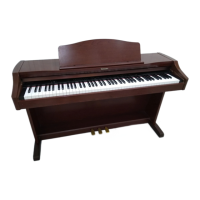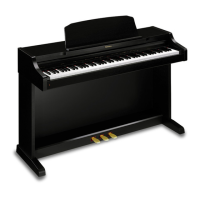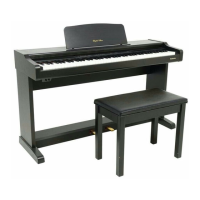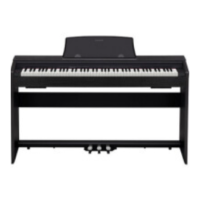
Do you have a question about the Technics SX-PX662 and is the answer not in the manual?
| Type | Digital Piano |
|---|---|
| Polyphony | 64 notes |
| Effects | Reverb, Chorus |
| Touch Sensitivity | 3 levels, Off |
| Keyboard | 88 keys, Hammer Action |
| Sound Source | PCM |
| Tones | Piano, Electric Piano, Organ, Strings, etc. |
| Recorder | 2 tracks |
| Pedals | Damper, Soft, Sostenuto |
| Connectivity | MIDI In/Out, Headphone jack, Line Out |
| Amplifier | 20W x 2 |
| Power Supply | AC adapter |
Precautions to reduce the risk of fire, electric shock, or product damage.
Details the equipment's compliance with FCC rules for digital devices.
Recommended reading for understanding the instrument and its setup.
Details the manual's sections: Preparative, Various Functions, and Reference Guide.
Lists essential accessories provided with the digital piano.
Essential safety guidelines for using electric products.
Cautionary advice on sound levels to prevent hearing loss.
Guidelines for product servicing and routine maintenance.
Instructions for plugging in, powering on, and initial settings.
Guidance on how to open and close the keyboard cover.
Instructions for assembling and attaching the music stand.
Note that the digital piano never needs tuning, but pitch can be adjusted.
How to play and listen to the grand piano demonstration tunes.
Instructions for listening to demonstration tunes of other sounds.
How to play all demonstration tunes sequentially.
How to choose and combine different instrument sounds.
Explanation of reverb and celeste effects for sound enhancement.
Details on the sostenuto and soft pedals.
Adjusting sound brightness and keyboard touch response.
Overview of display functions, sequencer, and sustain pedal operation.
How effect settings are stored independently for each sound.
How to select and play the 9 different organ sounds.
Instructions for playing two sounds simultaneously and adjusting their volume balance.
How to change the key of the song to suit your voice.
How to adjust the instrument's pitch for ensemble playing.
How to select and adjust the type and depth of digital reverb.
How to adjust the amount of sympathetic string resonance.
How to turn on/off, adjust tempo, and select metronome sound.
Adjusting metronome volume and adding accents to beats.
Storing and playing back performances using two sequencer tracks.
Step-by-step guide to record a piano piece in the sequencer.
Detailed steps to record the first track of a performance.
Detailed steps to record the second track, synchronized with Track 1.
Information on storage capacity, overwriting, and metronome use.
Instructions for playing back recorded tracks and erasing them.
Setting piano tuning temperament and minimum key range.
How to return all settings to their default status via initialization.
Description of MIDI IN/OUT terminals and their purpose.
Lists the types of data that can be sent and received via MIDI.
How to set the MIDI channel for communication.
Setting up multi-timbre operation and Omni mode.
Managing program change, pedal, and digital effect transmission.
Configuring transpose data transmission and local control.
Using panel buttons with MODE SET to configure MIDI functions.
Chart showing the relationship between keyboard keys and MIDI note numbers.
How to transmit PROGRAM CHANGE numbers using keyboard keys.
Reference table for PROGRAM CHANGE numbers based on BANK and NUMBER.
Details on connecting pedals, line out, and auxiliary inputs.
Information on using headphones for silent practice.
Detailed guide on assembling the piano body and stand.
Points to check after assembly for stability and correct setup.
Final checks for parts, stability, and cord connections.
Explanation of how settings are retained in memory.
Details on transmitted and recognized MIDI messages.
Explanation of different MIDI modes (Poly, Mono, Omni).
Overview of keyboard, polyphony, sounds, and pedals.
Details on effects, transpose, tuning, metronome, and sequencer.
Information on MIDI, I/O ports, speakers, and power requirements.
Dimensions, weight, and included accessories.
List of demo songs, their titles, and composers for PX662 and PX664.











